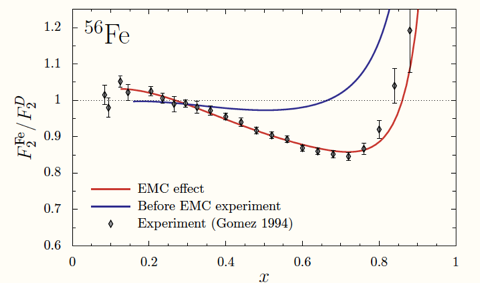The first “true” modification was measured by the EMC experiment in the early 80s, in that experiment the ratio of cross section for electron scattering off heavy nuclei and deuterium (heavy hydrogen, one proton and one neutron) was measured. Naively you would expect that the cross section for scattering off a nucleus would be the sum off the cross sections for scattering off the individual protons and neutrons, in fact, the experiment showed that for intermediate values of Bjorken x the cross section was much reduced from the simple sum. Several interpretations have been suggested for these data, but they mostly belong to two classes:
- The modification happens because the nucleon is in the nuclear medium - this could mean, for example, that the scattered electron sometimes hits the pions which are exchanged between the nucleons and are the force carriers for the residual strong force, or,
- It is the nucleons themselves that are modified in the medium, one intriguing suggestion is, for example, that nucleons embedded in the nuclear medium “swell”, that is, their size changes, and this causes the effect.

Since the EMC results there have been other experiment which also seem to suggest some modification of the nucleons.
In recent years a new class of experiments has been used to probe this effect. In these experiments the polarization components from of a proton knocked out of a nucleus (in quasi-free scattering, where the proton behaves almost like a free particle in the nucleus) are compared with those of a free proton. These experiments have shown a reduction in the polarization components for the bound proton, a result consistent with nucleon swelling (remember that naively, the polarization components are related to the form factors, which are in turn related to the charge distributions in the nucleon, i.e., it’s size). The following figure shows the ratio of polarization components for protons knocked out from helium-4 to those of a free proton (helium-4 is chosen since it is the densest nucleus, and would thus show the greatest effect), it this plot, no effect would show up as a super-ratio of one.

In 2009, in collaboration with a theorists from the University of Washington in Seattle, we published a theoretical prediction that the effects on the polarization components of a neutron in medium would be opposite in sign and larger in magnitude, based on these predictions our group is leading an experimental effort to propose and run a similar measurement to measure the polarization components of a neutron knocked out from a helium-4 nucleus. We plan to run this experiment at the Mainz MAMI accelerator in Germany and are collaborating with several groups in order to develop to proposal and, eventually, construct the necessary detector setup. At present we are busy simulating possible detector configurations and experimental condition in order to best design the experiment.
References:
- I.C. Cloet, G. A. Miller, E. Piasetzky, and G. Ron, Neutron Properties in the Medium, Phys. Rev. Lett 103, 082301 (2009)
- Schiavilla et al. Polarization Transfer in H4e(e→,e′p→)H3: Is the Ratio GEp/GMp Modified in the Nuclear Medium?. Phys. Rev. Lett. (2005) vol. 94 (7) pp. 072303